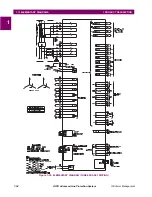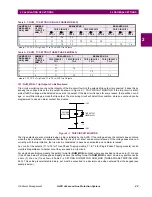
GE Power Management
ALPS Advanced Line Protection System
1-41
1 PRODUCT DESCRIPTION
1.10 OUT-OF-STEP TRIPPING (OPTIONAL)
1
1.10 OUT-OF-STEP TRIPPING (OPTIONAL)
1.10.1 DESCRIPTION
The Out-of-Step Tripping (OST) option is a positive-sequence static distance relay designed to provide out-of-step tripping
protection. It uses three modified Mho characteristics, all with the same forward and reverse reach along a common maxi-
mum reach angle, but each having a different shape (such as lens, circle or tomato). It includes logic and time delay circuits
that work with the modified-Mho characteristics to detect an out-of-step condition.
The OST function does not have a dedicated output relay, nor does it automatically initiate tripping via the ALPS trip output
relays. Rather, the output of the OST logic must be assigned by the user to an output relay, or to the configurable trip bus
input (CNFTRP, Index #122) if it is desired to trip the same circuit breaker as for a line fault.
Loss of synchronism or a power swing between two areas of a power system is detected by measuring the positive
sequence impedance seen by the relay over a period of time as the power swing develops. Since the OST option mea-
sures positive sequence impedance as seen at the relay location, there is less chance of setting up blocking for non-swing
conditions (such as close in single phase to ground faults on series compensated lines where gap flashing and capacitor
reinsertion can cause the fault impedance to vary greatly) than there is for a relay that measures phase impedance.
The OST option includes three positive sequence offset Mho distance relay characteristics. These characteristics have the
same reach along a common angle of maximum reach, but have different reaches along the R- axis. An out-of-step condi-
tion is detected by measuring the time it takes for the apparent impedance seen by the OST to travel from a load imped-
ance value to a point along the protected line. A fault on the line will cause this impedance change to occur immediately
and will not set up out-of-step tripping. For a swing condition the impedance will change slowly. If the impedance passes
through the three characteristics in the proper sequence, an out-of-step trip output is produced.
The basic mode of operation is with all three characteristics (OUTER, MIDDLE, INNER). However, by Protection Setting
1702: NUMBRCHAR, the MIDDLE characteristic can be bypassed, thereby using only the OUTER and INNER characteris-
tics for out-of-step detection. The decision whether to use two or three characteristics depends largely on the maximum slip
frequency expected during a swing condition. Three characteristics are preferred if the slip frequency is low enough to per-
mit making the minimum recommended settings on TLOS1, TLOS2 and TLOS3. In some applications only two characteris-
tics may be necessary, because the combination of a fast moving swing locus (high slip frequency) and a restricted OUTER
characteristic (due to heavy load transfer) prevents setting up the proper logic sequence.
There is another setting option that provides a choice between tripping as soon as the out-of-step condition is confirmed;
that is, on entering the INNER characteristic (Protection Setting 1703: TRIPIN_OUT = IN) or delaying tripping until the two
system voltages are more nearly in phase; that is, on leaving the OUTER characteristic (Protection Setting 1703:
TRIPIN_OUT = OUT). Some users prefer this delayed tripping to reduce the risk of damage to the circuit breaker that does
the tripping.
1.10.2 OST CHARACTERISTIC SHAPE
The shape of the offset Mho characteristic may be expanded or restricted by changing the characteristic timer setting. The
three Mho characteristics used in the OST function are shown below. All three have the same forward and reverse reach
along the maximum reach angle, but the OUTER characteristic is an expanded Mho (tomato-shaped) while the INNER
characteristic is a restricted Mho (lens shaped). The angle of maximum reach of the three characteristics is determined by
the positive sequence impedance angle of the protected line, Protection Setting 1401: POSSEQANG.
The dotted line in the figure below, SWING LOCUS, represents one possible path that would be followed by the apparent
impedance resulting from a swing, and it may travel either from left to right, or from right to left. Also, the SWING LOCUS
may be above the location shown, depending on the relationship between the relay location and the electrical center of the
power system.
Discrimination between a fault condition and a system swing is accomplished by checking the time taken for the apparent
impedance to move from the load condition (far outside the OUTER characteristic) to a point within the INNER characteris-
tic. This change occurs immediately for a fault condition, but at a much slower rate for a swing.
















































